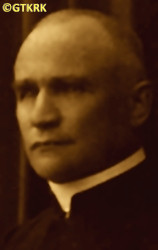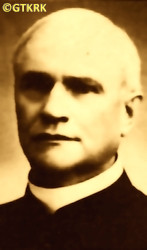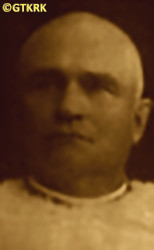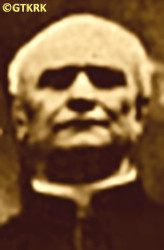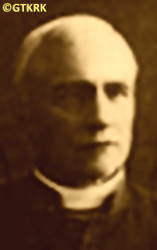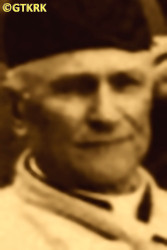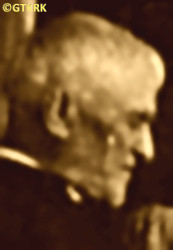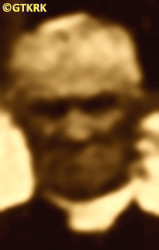Roman Catholic
St Sigismund parish
05-507 Słomczyn
85 Wiślana Str.
Konstancin deanery
Warsaw archdiocese, Poland
full list:
displayClick to display full list

searchClick to search full list by categories
wyświetlKliknij by wyświetlić pełną listę po polsku

szukajKliknij by przeszukać listę wg kategorii po polsku

Martyrology of the clergy — Poland
XX century (1914 – 1989)
personal data
surname
SZULC
forename(s)
Casimir (pl. Kazimierz)

function
diocesan priest
creed
Latin (Roman Catholic) Church RCmore on
en.wikipedia.org
[access: 2014.09.21]
diocese / province
Siedlce diocesemore on
en.wikipedia.org
[access: 2022.01.06]
Gniezno and Poznań archdiocese (aeque principaliter)more on
www.archpoznan.pl
[access: 2012.11.23]
Janów Podlaski diocesemore on
www.catholic-hierarchy.org
[access: 2021.12.19]
Lublin diocesemore on
pl.wikipedia.org
[access: 2013.05.19]
honorary titles
honorary canonmore on
honorary canon (St Mark the Evangelist RC basilica, Rometoday: Rome prov., Lazio reg., Italy
more on
en.wikipedia.org
[access: 2021.12.18])
date and place
of death
19.09.1941

KL Auschwitzconcentration camp
today: Oświęcim, Oświęcim gm., Oświęcim pov., Lesser Poland voiv., Poland
more on
en.wikipedia.org
[access: 2022.01.09]
details of death
After German and Russian invasion of Poland in 09.1939 and start of the World War II, after start of German occupation, attempted to return to his Siedlce diocese, then in German‐run Germ. Generalgouvernement (Eng. General Governorate).
Consent was required for Janowiec, where resided, was in a new German province, created in the German–occupied areas of Greater Poland, called Germ. Reichsgau Wartheland, separated by a guarded border from the General Governorate. Germans didn't grant such permission.
After refusal arrested by the Germans in Bydgoszcz.
There jailed.
Next on 30.08.1941 transported to KL Auschwitz concentration camp where was murdered in one of the first attempts to use Zyklon B gas to kill people (Germans murdered then c. 250 old, regarded as „infirm” Poles and c. 600 Russian POWs).
alt. details of death
According to some sources, arrested by the Germans in Janowiec „for preaching against the authorities of the Third Reich, for having sugar supplies at home and refusing to sign the Volksliste„— Germ. Deutsche Volksliste DVL, was a German nationality list introduced in the German–occupied territories Polish on 04.03.1941, that listed those who, after completing an extensive questionnaire and giving consent, were recognized as German or racially valuable; refusal to do so could result in the entire family being sent to a concentration or resettlement camp.
prisoner camp's numbers
20314Click to display source page (KL AuschwitzClick to display the description)
cause of death
extermination: exhaustion and starvation
perpetrators
Germans
sites and events
KL AuschwitzClick to display the description, Regierungsbezirk KattowitzClick to display the description, Bydgoszcz (prison)Click to display the description, GeneralgouvernementClick to display the description, Reichsgau WarthelandClick to display the description, Reichsgau Danzig‐WestpreußenClick to display the description, Ribbentrop‐MolotovClick to display the description, Pius XI's encyclicalsClick to display the description
date and place
of birth
23.08.1868

Miroszówtoday: Racławice gm., Miechów pov., Lesser Poland voiv., Poland
more on
en.wikipedia.org
[access: 2022.01.28]
presbyter (holy orders)
ordination
30.08.1891

positions held
1935 – 1941
resident — Janowiectoday: Janowiec Wielkopolski, Janowiec Wielkopolski gm., Żnin pov., Kuyavia‐Pomerania voiv., Poland
more on
en.wikipedia.org
[access: 2021.07.18] ⋄ St Nicholas the Bishop and Confessor RC parish ⋄ Janowiectoday: Janowiec Wielkopolski, Janowiec Wielkopolski gm., Żnin pov., Kuyavia‐Pomerania voiv., Poland
more on
en.wikipedia.org
[access: 2021.07.18] RC deanery — retired
from 19.06.1925
canon — Rometoday: Rome prov., Lazio reg., Italy
more on
en.wikipedia.org
[access: 2021.12.18] ⋄ St Mark the Evangelist RC church (basilica)
1922 – 1935
resident — Bydgoszcztoday: Bydgoszcz city pov., Kuyavia‐Pomerania voiv., Poland
more on
en.wikipedia.org
[access: 2021.06.20] ⋄ Sacred Heart of Jesus RC parish ⋄ Bydgoszcz‐citydeanery name
today: Bydgoszcz city pov., Kuyavia‐Pomerania voiv., Poland
more on
en.wikipedia.org
[access: 2021.06.20] RC deanery
1921 – 1922
parish priest — Krzesktoday: Krzesk‐Majątek, Zbuczyn gm., Siedlce pov., Masovia voiv., Poland
more on
en.wikipedia.org
[access: 2022.01.22] ⋄ Our Lady of Częstochowa RC parish ⋄ Siedlcetoday: Siedlce city pov., Masovia voiv., Poland
more on
en.wikipedia.org
[access: 2021.08.20] RC deanery
1913 – 1921
parish priest — Miastkówtoday: Miastków Kościelny, Miastków Kościelny gm., Garwolin pov., Masovia voiv., Poland
more on
en.wikipedia.org
[access: 2021.12.18] ⋄ Visitation and Annunciation of the Blessed Virgin Mary and St Leonard RC parish ⋄ Konstantynów / Żelechówdeanery names/seats
today: Lublin voiv., Poland RC deanery
1912 – 1913
parish priest — Skierbieszówtoday: Skierbieszów gm., Zamość pov., Lublin voiv., Poland
more on
en.wikipedia.org
[access: 2022.06.13] ⋄ Assumption of the Blessed Virgin Mary RC parish ⋄ Zamośćtoday: Zamość gm., Zamość pov., Lublin voiv., Poland
more on
en.wikipedia.org
[access: 2021.06.07] RC deanery
1911 – 1912
parish priest — Wola Gułowskaalso: Gułowska Wola
today: Adamów gm., Łuków pov., Lublin voiv., Poland
more on
en.wikipedia.org
[access: 2021.09.29] ⋄ Visitation of the Blessed Virgin Mary RC parish ⋄ Łukówtoday: Łuków urban gm., Łuków pov., Lublin voiv., Poland
more on
en.wikipedia.org
[access: 2020.09.24] RC deanery
1907 – 1911
parish priest — Ceranówtoday: Ceranów gm., Sokołów Podlaski pov., Masovia voiv., Poland
more on
en.wikipedia.org
[access: 2022.06.13] ⋄ Immaculate Conception of the Blessed Virgin Mary RC parish ⋄ Sokołów Podlaskitoday: Sokołów Podlaski gm., Sokołów Podlaski pov., Masovia voiv., Poland
more on
en.wikipedia.org
[access: 2021.09.29] RC deanery
1900 – 1907
parish priest — Górkitoday: Platerów gm., Łosice pov., Masovia voiv., Poland
more on
en.wikipedia.org
[access: 2022.06.13] ⋄ St Adalbert the Bishop and Martyr RC parish ⋄ Konstantynówtoday: Konstantynów gm., Biała Podlaska pov., Lublin voiv., Poland
more on
en.wikipedia.org
[access: 2021.12.19] RC deanery
1898 – 1900
vicar — Biała Podlaskatoday: Biała Podlaska city pov., Lublin voiv., Poland
more on
en.wikipedia.org
[access: 2021.08.20] ⋄ St Anne the mother of Blessed Virgin Mary RC parish ⋄ Biała Podlaskatoday: Biała Podlaska city pov., Lublin voiv., Poland
more on
en.wikipedia.org
[access: 2021.08.20] RC deanery
1896 – 1898
vicar — Rykitoday: Ryki gm., Ryki pov., Lublin voiv., Poland
more on
en.wikipedia.org
[access: 2022.06.13] ⋄ St James the Younger the Apostle RC parish ⋄ Garwolintoday: Garwolin gm., Garwolin pov., Masovia voiv., Poland
more on
en.wikipedia.org
[access: 2021.09.29] RC deanery
c. 1896
vicar — Żelechówtoday: Żelechów gm., Garwolin pov., Masovia voiv., Poland
more on
en.wikipedia.org
[access: 2022.06.13] ⋄ Annunciation to the Blessed Virgin Mary RC parish ⋄ Garwolintoday: Garwolin gm., Garwolin pov., Masovia voiv., Poland
more on
en.wikipedia.org
[access: 2021.09.29] RC deanery
1894 – 1896
vicar — Przesmykitoday: Przesmyki gm., Siedlce pov., Masovia voiv., Poland
more on
en.wikipedia.org
[access: 2021.08.20] ⋄ St James the Apostle RC parish ⋄ Konstantynówtoday: Konstantynów gm., Biała Podlaska pov., Lublin voiv., Poland
more on
en.wikipedia.org
[access: 2021.12.19] RC deanery
1892 – 1894
vicar — Garbówtoday: Garbów gm., Lublin pov., Lublin voiv., Poland
more on
en.wikipedia.org
[access: 2021.08.20] ⋄ St Adalbert the Bishop and Martyr RC parish ⋄ Nowo‐Aleksandryatoday: Puławy, Puławy urban gm., Puławy pov., Lublin voiv., Poland
more on
en.wikipedia.org
[access: 2021.08.20] RC deanery
1892
vicar — Piotrawintoday: Łaziska gm., Opole Lubelskie pov., Lublin voiv., Poland
more on
en.wikipedia.org
[access: 2021.09.29] ⋄ St Thomas the Apostle RC parish ⋄ Nowo‐Aleksandryatoday: Puławy, Puławy urban gm., Puławy pov., Lublin voiv., Poland
more on
en.wikipedia.org
[access: 2021.08.20] RC deanery
1891 – 1892
vicar — Łukówtoday: Łuków urban gm., Łuków pov., Lublin voiv., Poland
more on
en.wikipedia.org
[access: 2020.09.24] ⋄ Transfiguration of the Lord RC parish ⋄ Łukówtoday: Łuków urban gm., Łuków pov., Lublin voiv., Poland
more on
en.wikipedia.org
[access: 2020.09.24] RC deanery
till 1891
student — Lublintoday: Lublin city pov., Lublin voiv., Poland
more on
en.wikipedia.org
[access: 2021.08.20] ⋄ philosophy and theology, Theological Seminary
student — Kielcetoday: Kielce city pov., Holy Cross voiv., Poland
more on
en.wikipedia.org
[access: 2021.06.07] ⋄ philosophy and theology, Theological Seminary
sites and events
descriptions
KL Auschwitz: German Germ. Konzentrationslager (Eng. concentration camp) KL and Germ. Vernichtungslager (Eng. extermination camp) VL Auschwitz was set up by Germans around 27.01.1940 n. Oświęcim, on the German territory (initially in Germ. Provinz Schlesien — Silesia Province; and from 1941 Germ. Provinz Oberschlesien — Upper Silesia Province). Initially mainly Poles were interned. From 1942 it became the centre for holocaust of European Jews. Part of the KL Auschwitz concentration camps’ complex was Germ. Vernichtungslager (Eng. extermination camp) VL Auschwitz II Birkenau, located not far away from the main camp. There Germans murder possibly in excess of million people, mainly Jews, in gas chambers. Altogether In excess of 400 priests and religious went through the KL Auschwitz, approx. 40% of which were murdered (mainly Poles). (more on: en.auschwitz.org.plClick to attempt to display webpage
[access: 2012.11.23], www.meczennicy.pelplin.plClick to attempt to display webpage
[access: 2013.07.06])
Regierungsbezirk Kattowitz: After the Polish defeat in the 09.1939 campaign, which was the result of the Ribbentrop‐Molotov Pact and constituted the first stage of World War II, and the beginning of German occupation in part of Poland (in the other, eastern part of Poland, the Russian occupation began), the Germans divided the occupied Polish territory into five main regions (and a few smaller). The largest one was transformed into Germ. Generalgouvernement (Eng. General Governorate), intended exclusively for Poles and Jews and constituting part of the so‐called Germ. Großdeutschland (Eng. Greater Germany). From two separate new provinces were created. The two remaining were incorporated into existing German provinces. One of those was Polish Upper Silesia, which on 08.09.1939, by decree of the German leader Adolf Hitler (formally came into force on 26.10.1939), was incorporated into Germany as the Germ. Regierungsbezirk Kattowitz (Eng. Katowice Regency) and became part of the Germ. Provinz Schlesien (Eng. Province of Silesia) based in Wrocław. On 01.04.1940, the Germ. Regierungsbezirk Kattowitz was enlarged by several pre‐war German counties, and on 18.01.1941, a new German province was created, the Germ. Provinz Oberschlesien (Eng. Province of Upper Silesia), which, apart from the Germ. Regierungsbezirk Kattowitz, also included the Opole region. From 26.10.1939, when the regency was established, the law of the German state was in force there, the same as in Berlin. The main axis of the policy of the new regency, the territory of which the Germans recognized as the Germ. „Ursprünglich Deutsche” (Eng. „natively German”), despite the fact only 6% of its pre–war Polish part were Germans, was Germ. „Entpolonisierung” (Eng. „Depolonisation”), i.e. forced Germanization. The main mechanism was the introduction of the Germ. Deutsche Volksliste DVL, a German nationality list that was supposed to specify the national affiliation of the inhabitants of the region. The largest group marked in the compulsory registrations was Group 3, people who identified themselves as „Silesians” (in 1943 about 41%), and people remaining outside the DVL (about 36%). The latter group was intended to be deported to the Germ. Generalgouvernement (which did not happen en masse because German industry needed slave labor). Group 3, considered by the Germans as capable of Germanization, was subject to certain legal restrictions, and was subject to, among others, to conscription into the German Wehrmacht army. Children could only learn in German. A policy of terror was pursued against the Polish population. There was a special police court, controlled by the Germ. Geheime Staatspolizei (Eng. Secret State Police), i.e. the Gestapo, before which c. 4,000‐5,000 people were detained. For the years 1942‐1945 over 2,000 of them were verified, of which 1,890 were sentenced to death, including 286 in public executions. Thousands of people were murdered during the so‐called «Intelligenzaktion Schlesien», including 300‐650 Polish teachers and c. 61 Polish Catholic priests. The regency hosted a German concentration and extermination camp KL Auschwitz, where the Germans imprisoned c. 1,100,000 Jews (murdering c.1,000,000, i.e. c. 90% of them) and c. 140,000 Poles (murdering c. 70,000, i.e. c. 50% of them). After the end of hostilities of World War II, the overseer of this province, the Germ. Reichsstatthalter (Eng. Reich Governor) and the Germ. Gauleiter (Eng. district head) of the German National Socialist Party, Fritz Brecht, committed suicide. (more on: en.wikipedia.orgClick to attempt to display webpage
[access: 2024.06.24])
Bydgoszcz (prison): Detention centre and court prison run by Germans. Those arrested in the detention centre were usually transported next to concentration cams. In 1945 the prison was evacuated — out 350 prisoners marched off from prison only 27 survived. (more on: www.sw.gov.plClick to attempt to display webpage
[access: 2013.10.05])
Generalgouvernement: After the Polish defeat in the 09.1939 campaign, which was the result of the Ribbentrop‐Molotov Pact and constituted the first stage of World War II, and the beginning of German occupation in part of Poland (in the other, eastern part of Poland, the Russian occupation began), the Germans divided the occupied Polish territory into five main regions. In two of them new German provinces were created, two other were incorporated into other provinces. However, the fifth part was treated separately, and in a political sense it was supposed to recreate the German idea from 1915 (during World War I, after the defeat of the Russians in the Battle of Gorlice in 05.1915) of creating a Polish enclave within Germany. Illegal in the sense of international law, i.e. Hague Convention, and public law, managed by the Germans according to separate laws — especially established for the Polish Germ. Untermenschen (Eng. subhumans) — till the Russian offensive in 1945 it constituted part of the Germ. Großdeutschland (Eng. Greater Germany). Till 31.07.1940 formally called Germ. Generalgouvernement für die besetzten polnischen Gebiete (Eng. General Government for the occupied Polish lands) — later simply Germ. Generalgouvernement (Eng. General Governorate), as in the years 1915‐1918. From 07.1941, i.e. after the German attack on 22.06.1941 against the erstwhile ally, the Russians, it also included the Galicia district, i.e. the Polish pre‐war south‐eastern voivodeships. A special criminal law was enacted and applied to Poles and Jews, allowing for the arbitrary administration of the death penalty regardless of the age of the „perpetrator”, and sanctioning the use of collective responsibility. After the end of the military conflict of the World War UU, the government of the Germ. Generalgouvernement was recognized as a criminal organization, and its leader, governor Hans Frank, guilty of war crimes and crimes against humanity and executed. (more on: en.wikipedia.orgClick to attempt to display webpage
[access: 2024.12.13])
Reichsgau Wartheland: After the Polish defeat in the 09.1939 campaign, which was the result of the Ribbentrop‐Molotov Pact and constituted the first stage of World War II, and the beginning of German occupation in part of Poland (in the other, eastern part of Poland, the Russian occupation began), the Germans divided the occupied Polish territory into five main regions (and a few smaller). The largest one was transformed into Germ. Generalgouvernement (Eng. General Governorate), intended exclusively for Poles and Jews and constituting part of the so‐called Germ. Großdeutschland (Eng. Greater Germany). Two were added to existing German provinces. From two other separate new provinces were created. Greater Poland region was one of them, incorporated into Germany on 08.10.1939, by decree of the German leader Adolf Hitler (formally came into force on 26.10.1939), and on 24.01.1940 transformed into the Germ. Reichsgau Wartheland province, in which the law of the German state was to apply. The main axis of the policy of the new province, the territory of which the Germans recognized as the Germ. „Ursprünglich Deutsche” (Eng. „natively German”), despite the fact that 90% of its inhabitants were Poles, was Germ. „Entpolonisierung” (Eng. „Depolonisation”), i.e. forced Germanization. C. 100,000 Poles were murdered as part of the Germ. „Intelligenzaktion”, i.e. extermination of Polish intelligentsia and ruling classes. C. 630,000 were forcibly resettled to the Germ. Generalgouvernement, and their place taken by the Germans brought from other areas occupied by Germany (e.g. the Baltic countries, Bessarabia, Bukovina, etc.). Poles were forced to sign the German nationality list, the Germ. Deutsche Volksliste DVL. As part of the policy of „Ohne Gott, ohne Religion, ohne Priesters und Sakramenten” (Eng. „No God, no religion, no priest or sacrament”) most Catholic priests were arrested and sent to concentration camps. All schools teaching in Polish, Polish libraries, theaters and museums were closed. Polish landed estates confiscated. To further reduce the number of the Polish population, Poles were sent to forced labor deep inside Germany, and the legal age of marriage for Poles was increased (25 for women, 28 for men). The German state office, Germ. Rasse‐ und Siedlungshauptamt (Eng. Main Office of Race and Settlement) RuSHA, under the majesty of German law, abducted several thousand children who met specific racial criteria from Polish families and subjected them to forced Germanization, handing them over to German families. After the end of hostilities of World War II, the overseer of this province, the Germ. Reichsstatthalter (Eng. Reich Governor) and the Germ. Gauleiter (Eng. district head) of the German National Socialist Party, Arthur Karl Greiser, was executed. (more on: en.wikipedia.orgClick to attempt to display webpage
[access: 2024.06.21])
Reichsgau Danzig‐Westpreußen: After the Polish defeat in the 09.1939 campaign, which was the result of the Ribbentrop‐Molotov Pact and constituted the first stage of World War II, and the beginning of German occupation in part of Poland (in the other, eastern part of Poland, the Russian occupation began), the Germans divided the occupied Polish territory into five main regions (and a few smaller). The largest one was transformed into Germ. Generalgouvernement (Eng. General Governorate), intended exclusively for Poles and Jews and constituting part of the so‐called Germ. Großdeutschland (Eng. Greater Germany). Two were added to existing German provinces. From two other separate new provinces were created. Vistula Pomerania region was one of them, incorporated into Germany on 08.10.1939, by decree of the German leader Adolf Hitler (formally came into force on 26.10.1939), and on 02.11.1939 transformed into the Germ. Reichsgau Danzig‐Westpreußen (Eng. Reich District of Gdańsk‐West Prussia) province, in which the law of the German state was to apply. The main axis of the policy of the new province, the territory of which the Germans recognized as the Germ. „Ursprünglich Deutsche” (Eng. „natively German”), despite the fact that 85% of its inhabitants were Poles, was Germ. „Entpolonisierung” (Eng. „Depolonisation”), i.e. forced Germanization. C. 60,000 Poles were murdered in 1939‐1940, as part of the Germ. „Intelligenzaktion”, i.e. extermination of Polish intelligentsia and ruling classes, in c. 432 places of mass executions — including c. 220 Polish Catholic priests. The same number were sent to German concentration camps, from where few returned (over 300 priests were arrested, of whom c. 130 died in concentration camps). C. 124,000‐170,000 were displaced, including c. 90,000 to the Germ. Generalgouvernement. Poles were forced en masse to sign the German nationality list, the Germ. Deutsche Volksliste DVL. Polish children could only learn in German. It was forbidden to use the Polish language during Catholic Holy Masses and during confession. Polish landed estates were confiscated..To further reduce the number of the Polish population, Poles were sent to forced labor deep inside Germany. The remaining Poles were treated as low‐skilled labor, isolated from the Germans and strictly controlled — legally, three or three of them could only meet together, even in their own apartments. Many were conscripted into the German Wehrmacht army. After the end of hostilities of World War II, the overseer of this province, the Germ. Reichsstatthalter (Eng. Reich Governor) and the Germ. Gauleiter (Eng. district head) of the German National Socialist Party, Albert Maria Forster, was executed. (more on: en.wikipedia.orgClick to attempt to display webpage
[access: 2024.06.24])
Ribbentrop‐Molotov: Genocidal Russian‐German alliance pact between Russian leader Joseph Stalin and German leader Adolf Hitler signed on 23.08.1939 in Moscow by respective foreign ministers, Mr. Vyacheslav Molotov for Russia and Joachim von Ribbentrop for Germany. The pact sanctioned and was the direct cause of joint Russian and German invasion of Poland and the outbreak of the World War II in 09.1939. In a political sense, the pact was an attempt to restore the status quo ante before 1914, with one exception, namely the „commercial” exchange of the so‐called „Kingdom of Poland”, which in 1914 was part of the Russian Empire, fore Eastern Galicia (today's western Ukraine), in 1914 belonging to the Austro‐Hungarian Empire. Galicia, including Lviv, was to be taken over by the Russians, the „Kingdom of Poland” — under the name of the General Governorate — Germany. The resultant „war was one of the greatest calamities and dramas of humanity in history, for two atheistic and anti‐Christian ideologies — national and international socialism — rejected God and His fifth Decalogue commandment: Thou shall not kill!” (Abp Stanislav Gądecki, 01.09.2019). The decisions taken — backed up by the betrayal of the formal allies of Poland, France and Germany, which on 12.09.1939, at a joint conference in Abbeville, decided not to provide aid to attacked Poland and not to take military action against Germany (a clear breach of treaty obligations with Poland) — were on 28.09.1939 slightly altered and made more precise when a treaty on „German‐Russian boundaries and friendship” was agreed by the same murderous signatories. One of its findings was establishment of spheres of influence in Central and Eastern Europe and in consequence IV partition of Poland. In one of its secret annexes agreed, that: „the Signatories will not tolerate on its respective territories any Polish propaganda that affects the territory of the other Side. On their respective territories they will suppress all such propaganda and inform each other of the measures taken to accomplish it”. The agreements resulted in a series of meeting between two genocidal organization representing both sides — German Gestapo and Russian NKVD when coordination of efforts to exterminate Polish intelligentsia and Polish leading classes (in Germany called «Intelligenzaktion», in Russia took the form of Katyń massacres) where discussed. Resulted in deaths of hundreds of thousands of Polish intelligentsia, including thousands of priests presented here, and tens of millions of ordinary people,. The results of this Russian‐German pact lasted till 1989 and are still in evidence even today. (more on: en.wikipedia.orgClick to attempt to display webpage
[access: 2015.09.30])
Pius XI's encyclicals: Facing the creation of two totalitarian systems in Europe, which seemed to compete with each other, though there were more similarities than contradictions between them, Pope Pius XI issued in 03.1937 (within 5 days) two encyclicals. In the „Mit brennender Sorge” (Eng. „With Burning Concern”) published on 14.03.1938, condemned the national socialism prevailing in Germany. The Pope wrote: „Whoever, following the old Germanic‐pre‐Christian beliefs, puts various impersonal fate in the place of a personal God, denies the wisdom of God and Providence […], whoever exalts earthly values: race or nation, or state, or state system, representatives of state power or other fundamental values of human society, […] and makes them the highest standard of all values, including religious ones, and idolizes them, this one […] is far from true faith in God and from a worldview corresponding to such faith”. On 19.03.1937, published „Divini Redemptoris” (Eng. „Divine Redeemer”), in which criticized Russian communism, dialectical materialism and the class struggle theory. The Pope wrote: „Communism deprives man of freedom, and therefore the spiritual basis of all life norms. It deprives the human person of all his dignity and any moral support with which he could resist the onslaught of blind passions […] This is the new gospel that Bolshevik and godless communism preaches as a message of salvation and redemption of humanity”… Pius XI demanded that the established human law be subjected to the natural law of God , recommended the implementation of the ideal of a Christian state and society, and called on Catholics to resist. Two years later, National Socialist Germany and Communist Russia came together and started World War II. (more on: www.vatican.vaClick to attempt to display webpage
[access: 2023.05.28], www.vatican.vaClick to attempt to display webpage
[access: 2023.05.28])
sources
personal:
www.opoka.org.plClick to attempt to display webpage
[access: 2012.12.28], expressbydgoski.plClick to attempt to display webpage
[access: 2024.01.22], www.geni.comClick to attempt to display webpage
[access: 2024.01.22], www.straty.plClick to attempt to display webpage
[access: 2019.10.30], www.archiwum.archidiecezja.plClick to attempt to display webpage
[access: 2013.08.10]
original images:
www.geni.comClick to attempt to display webpage
[access: 2024.01.22], www.geni.comClick to attempt to display webpage
[access: 2024.01.22], www.geni.comClick to attempt to display webpage
[access: 2024.01.22], www.geni.comClick to attempt to display webpage
[access: 2024.01.22], www.geni.comClick to attempt to display webpage
[access: 2024.01.22], www.geni.comClick to attempt to display webpage
[access: 2024.01.22], www.geni.comClick to attempt to display webpage
[access: 2024.01.22], www.geni.comClick to attempt to display webpage
[access: 2024.01.22], www.geni.comClick to attempt to display webpage
[access: 2024.01.22]
LETTER to CUSTODIAN/ADMINISTRATOR
If you have an Email client on your communicator/computer — such as Mozilla Thunderbird, Windows Mail or Microsoft Outlook, described at WikipediaPatrz:
en.wikipedia.org, among others — try the link below, please:
LETTER to CUSTODIAN/ADMINISTRATORClick and try to call your own Email client
If however you do not run such a client or the above link is not active please send an email to the Custodian/Administrator using your account — in your customary email/correspondence engine — at the following address:

giving the following as the subject:
MARTYROLOGY: SZULC Casimir
To return to the biography press below:
 Click to return to biography
Click to return to biography








